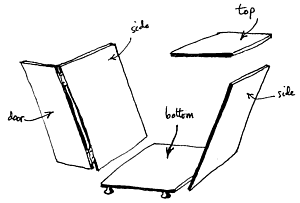DIY Project No. 698
A Simple but Attractive Orange Box
by Arnold Hipflask

Fig. 1
Constituent parts of a wardrobe
There are several reasons for doing such a thing. Firstly, an unwanted wardrobe is a considerable nuisance, occupying valuable space in the bedroom which could be used for more useful items such as non-lubricating reciprocating compressors. Secondly, good quality orange boxes are now very hard to come by, and in my opinion there is no better way to accommodate this type of fruit in the home.
The procedure is very simple - refer to fig. 3. First, lie on back and remove drawers. Loosen and discard any other garments. The bottom is then exposed (although it is of course now at the side). Have a good look at it, and if there are any unwanted dimples, fill them with a proprietary filler such as Rissodimp (available at all good hardware establishments, a snip at only 3/9d per lb exc. purchase tax).
In the early stages, disassembly is most easily effected by standing inside the wardrobe. Using a 20lb sledge hammer, start by giving the upper left support batten a couple of vigorous "taps" - it may be necessary to open the door to get a good swing. Some care is necessary to avoid the top flying off, possibly through a window, and causing distress to passers-by. A certain amount of noise is inevitable.

Fig. 2
The completed orange box
Having dismantled the wardrobe, gather the wreckage together and sand down the panels to remove any rough edges. In this task you will find a Rissoletone Megasand Deluxe 5000 a considerable boon (£5/19/6d plus purchase tax). However do take care, because this powerful machine can render the entire wardrobe into a pile of dust in minutes.
With reference to the detailed illustration shown above, construct the orange box using the cantilevered braced-truss method (see article 395) with chamfered end battens; a tried and trusted technique, pioneered by Williamson in his famous Britannia coffin design (1932) - reprints available.
The dovetailed corner pieces should be machined carefully with a Jones Mk.3 jig, making sure that the included angle is exactly 39.3°. Otherwise you will have problems when fitting section 2(B) to the upper protruding spigot. Finally, apply several liberal coats of Rissothane lacquer, sanding down between applications.
Should you decide later that you have little use for your orange box, you can always turn it back into a wardrobe as described in an earlier article.
Next week I will describe how to construct a simple but attractive table lamp from a few old coat hangers.
© Bluebottle Weekly, 1996 Reproduced with permission

